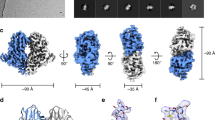Summary
Immunogold electron microscopy revealed that site-specific antibodies elicited by a synthetic peptide representing the N-terminal sequence (residues 2–10) of influenza virus M 2 protein were capable of binding to the surface of virions. Antibody binding was observed with two human influenza virus strains but not with an avian virus strain which has amino acid substitutions in the appropriate sequence of M 2. These results provide direct evidence for the presence of M 2 in the influenza virion.
Similar content being viewed by others
References
Air GM (1979) Nucleotide sequence coding for the signal peptide and N-terminus of the hemagglutinin from an Asian (H2N2) strain of influenza virus. Virology 97: 468–472
Barany G, Merrifield RB (1980) Solid-phase peptide synthesis. In: Gross E, Meienhofer J (eds) The peptides: analysis, synthesis and biology, vol 2, special methods in peptide synthesis, part A. Academic Press, New York, pp 1–284
Bean WJ, Threlkeld SC, Webster RG (1989) Biologic potential of amantadine-resistant influenza A virus in an avian model. J Infect Dis 159: 1050–1056
Buckler-White AJ, Naeve CW, Murphy BR (1986) Characterization of a gene coding for M proteins which is involved in host range restriction of an avian influenza A virus in monkeys. J Virol 57: 697–700
Hay AJ, Wolstenholme AJ, Smith MH (1985) The molecular basis of the specific anti-influenza action of amantadine. EMBO J 4: 3021–3024
Kent SBH, Hood LE (1984) A novel approach to automated peptide synthesis based on new insights into solid phase chemistry. In: Izumiya N (ed) Peptide chemistry. Protein Research Foundation, Osaka, pp 217–222
Kida H, Brown LE, Webster RG (1982) Biological activity of monoclonal antibodies to operationally defined antigenic regions on the hemagglutinin molecule of A/seal/Massachusettes/1/80 (H7N7) influenza virus. Virology 122: 38–47
Kohler G, Milstein C (1976) Derivation of specific antibody-producing tissue culture and tumour lines by cell fusion. Eur J Immunol 6: 511–519
Kyte J, Doolittle RF (1970) A simple method for displaying the hydropathic character of a protein. J Mol Biol 157: 105–132 1982
Lamb RA (1983) The influenza virus RNA segments and their encoded proteins. In: Palese P, Kingsbury DW (eds) Genetics of influenza viruses. Springer, Wien New York, pp 21–98
Lamb RA, Choppin PW (1979) Segment 8 of the influenza virus genome is unique in coding for two polypeptides. Proc Natl Acad Sci USA 76: 4908–4912
Lamb RA, Choppin PW (1981) Identification of a second protein (M 2) encoded by RNA segment 7 of influenza virus. Virology 112: 729–737
Lamb RA, Lai CJ (1981) Conservation of the influenza virus membrane protein (M 1) amino acid sequence and an open reading frame of RNA segment 7 encoding a second protein (M 2) in H1N1 and H3N2 strains. Virology 112: 746–751
Lamb RA, Lai CJ, Choppin PW (1981) Sequences of mRNAs derived from genome RNA segment 7 of influenza virus: colinear and interrupted mRNAs code for overlapping proteins. Proc Natl Acad Sci USA 78: 4170–4174
Lamb RA, Zebedee SL, Richardson CD (1985) Influenza virus M 2 protein is an integral membrane protein expressed on the infected-cell surface. Cell 40: 627–633
Laver WG, Gerhard W, Webster RB, Frankel ME, Air GM (1979) Antigenic drift in influenza A viruses: peptide mapping and antigenic analysis of A/PR/8/34 (H0N1) variants selected with monoclonal antibodies. Proc Natl Acad Sci USA 76: 1425–1429
McCauley JW, Mahy BWJ, Ingles SC (1982) Nucleotide sequence of fowl plague virus RNA segment 7. J Gen Virol 58: 211–215
Murti KG, Bean WJ, Webster RG (1980) Helical ribonucleoproteins of influenza virus: an electron microscopic analysis. Virology 104: 224–229
Murti KG, Webster RG (1986) Distribution of hemagglutinin and neuraminidase on influenza virions as revealed by immunoelectron microscopy. Virology 149: 36–43
Murti KG, Portner A, Troughton K, Deshpande K (1985) Localization of proteins on viral nucleocapsids using immuno-electron microscopy. J Electron Microsc Tech 2: 139–146
Sanger F, Nicklen S, Coulson AR (1977) DNA sequencing with chain terminating inhibitors. Proc Natl Acad Sci USA 74: 5463–5467
Tang X-L, Tregear GW, White DO, Jackson DC (1988) The minimum requirements for immunogenicity and antigenicity of synthetic peptide homologs of influenza virus hemagglutinin. J Virol 62: 4745–4751
Taylor HP, Armstrong SJ, Dimmock NJ (1987) Quantitative relationships between an influenza virus and neutralizing antibody. Virology 159: 288–298
Webster RG, Hinshaw VS, Laver WG (1982) Selection and analysis of antigenic variants of the neuraminidase of N 2 influenza virus with monoclonal antibodies. Virology 117: 93–104
Webster RG, Laver WG (1980) Determination of the number of non-overlapping antigenic areas on Hong Kong (H3N2) influenza virus hemagglutinin with monoclonal antibodies and the selection of variants with potential epidemiological significance. Virology 104: 139–148
Winter G, Fields S (1980) Cloning of influenza cDNA into M 13: the sequence of the RNA segment encoding the A/PR/8/34 matrix protein. Nucleic Acids Res 8: 1965–1974
Zebedee SL, Lamb RA (1988) Influenza A virus M 2 protein: monoclonal antibody restriction of virus growth and detection of M 2 in virions. J Virol 62: 6763–6772
Author information
Authors and Affiliations
Rights and permissions
About this article
Cite this article
Jackson, D.C., Tang, XL., Murti, K.G. et al. Electron microscopic evidence for the association of M 2 protein with the influenza virion. Archives of Virology 118, 199–207 (1991). https://doi.org/10.1007/BF01314030
Received:
Accepted:
Issue Date:
DOI: https://doi.org/10.1007/BF01314030




